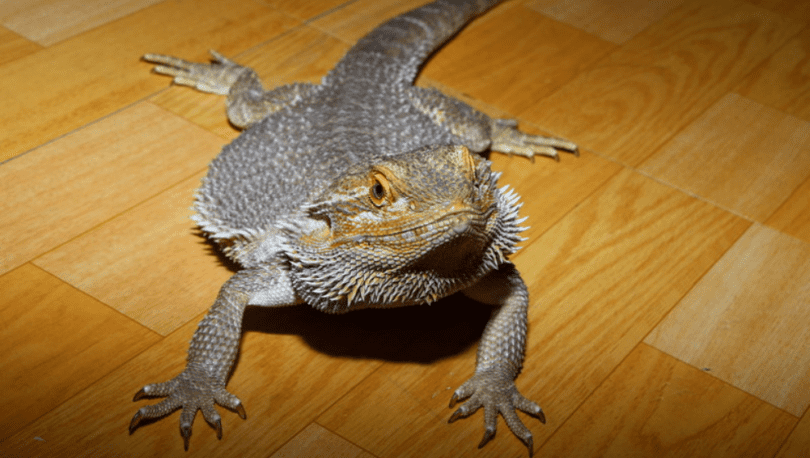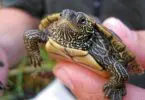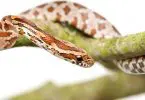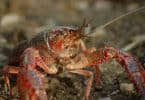Most of the people who started with bearded dragons fall in love with the reptilian family. They then want to make additions to their family by adding in multiple other species. Moreover, herpetologists are always interested in adding new species to their reptile collection.
If you are also one of these people, you must be wondering how to house your bearded dragon well with other reptile and amphibian pets. One of the most popular reptiles people are interested in getting is the tortoise. They are low maintenance, mild in their behavior, very friendly, and long-living. However, can they survive well with your beardies? Let us find out in this blog post.
Table of Contents
Can Bearded Dragons Live Well With The Tortoise?
Yes, Both Bearded Dragons and tortoises are very friendly. Therefore, they can survive well with each other.
Pet tortoises are very accommodating so do bearded dragons. They do not mind the presence of any other species around unless they become a threat to their existence. So, if you are housing both these pets under the same roof, they will be very friendly.
I have seen multiple reptile owners who have housed other pets successfully with bearded dragons. One of the best species that get well along with beardies is tortoises and turtles.
Even if both species are super innoxious to each other, you still need to meet specific criteria to not spark the existential crisis in both. Or they will start attacking each other so ruthlessly that it will cause the death or severe injury of any two.
Do Bearded Dragons & Tortoises Get Along Housed In The Same Room?
Yes, Bearded Dragons and Tortoises get well in the same room. However, using the same terrarium for both(no matter how big) is not recommended.
Undoubtedly, pet bearded dragons and tortoises live with each other quite well, but which animal will tolerate the competition for food, water, and space.
Therefore, it is not recommended to house both in the same tank. If you do so, there will be a high chance that a sense of rivalry develops among them for food and accommodation.
In most cases, both of these reptiles can be innoxious in their direct contact with their fellow reptiles sharing the same house with them. In fact, I have seen multiple cases where both the creatures are pretty entertaining for both. Thus, increasing each other’s activity level and killing boredom.
So, housing them in different tanks but in the same room seems quite reasonable.
However, there are also cases when both do not get along very well. Either bearded dragon, tortoise, or both do not tolerate the sight of other reptiles. This behavior is more common in adult age reptiles. Baby tortoises and bearded dragons are more acclimatizing and accepting of their environment than the adult ones. However, in the case of adult reptiles, especially males, they tend to develop territorial behaviors.
The intolerant behavior can also be because of fear. For example, you have an adult giant bearded dragon in front of a small tortoise or turtle. So, its freaking out is quite natural, even if a bearded dragon means no harm. Forcing them to stay together will put unnecessary stress on your pet. This will have deplorable consequences on the health of your pet.
What To Do If The Sight Of Other Stresses Either Of My Reptile Pet?
The behavior of a pet towards other species not only depends only the species general nature but also on the individual temperament. Therefore, if your reptile is getting stressed out or is aggravated by the sight of a member of another species, be ready to provide both a separate room.
Before getting a new reptile member, always prepare your mind for the worst. Check if you have a separate room for both pets.
How will you cope with the situation when both individuals are not okay living together. Sometimes placing the tank so far apart or decorating it in a way that your reptiles cannot see each other directly or don’t feel the presence of other pets under the same roof solves the problem.
However, you always manage a case-sensitive solution. Pre-planning for the worst before getting a pet is essential in order to ensure the maximum health and safety of both pets.
Tips For Better Housing of Bearded Dragons & Tortoises Together:
There are certain things that will help your different species’ pets get along quickly if you are careful. Let us talk about them in detail.
Quarantine New Reptile For One Month
Well, this step might not be essential to introduce behavioral changes in any of the pets. However, it is necessary to ensure the safety of both.
Whenever you get a new reptile(tortoise in this case), get it thoroughly examined by a vet specializing in reptiles. You can then quarantine it at your home for one month.
Quarantining reptile means keeping it away from all the other animals and children at your home. Reptiles bear a lot of bacteria and other infectious agents as ticks and mites. Quarantining will help you identify if your pet is infested and protect all the other species.
Pet bearded dragons are pretty prone to ticks and mites infestation. You can check for the diseases in bearded dragons in the health and disease section of bearded dragons. Therefore, to protect them from any possible infestation, do not allow them to contact any other reptile unless you are sure it is entirely safe.
You can quarantine your tortoise by housing it in a separate room where your pet beardie or children don’t reach.
Always Be Gradual In Introducing New Reptiles!
Once you have successfully quarantined your tortoise and you are confident that it does not have any parasite residing on it, you can then introduce your tortoise to your bearded dragon.
Introducing new reptiles to each other should not be aggressive. You should not force any of them to go near each other if they do not want to. Let them see their mate for a few minutes. Then separate them. You can then increase the meeting time day by day. Once you know, they are entirely comfortable with each other and are coping well with each other existence, and you can then let them be and enjoy their new friend’s company.
Moreover, give each of them a lot of personal space… a space to hide and live independently if they want to. Don’t make your pets share the terrarium.
Have Abundant Food!
Even if your pets are getting along well usually, nobody can guarantee if they are going to fight the very next moment or not. So, better keep an eye on them when they are together. Also, have the things in abundance that can attract the interest of both. Do not tell them to share a thing, or they will compete for it, especially food!
Tortoise is real food beggers and can do anything for food. So, better ensure you don’t let the two reptiles meet at lunch or allow them to go in each other’s tank. Otherwise, none of them will be reluctant to eat the leftover, which can be really dangerous.
Never Limit The Space:
If you cannot afford two terrariums or want the two reptiles to share the place temporarily, make sure it is big enough. Reptiles need quite a large surface to exercise, a basking spot, a place to hide, eat, and drink.
So, if your enclosure is small, it will ultimately lead to severe competition between both pets for life essentials. This can cause severe injuries to both and may also lead to the death of any. So, better be very careful in this prospect.
Moreover, when you are getting a larger tank, make sure your heating source meets both species’ habitat needs. Also, the light source is good enough for the whole large tank. Keeping one side in less light will again cause the competition for a better place between the two.
Make Sure None Of Your Pets Is Stressed:
Keep a close eye on the behavior of both pets. If it seems anyone of them is stressed or freaks out in the company of the other, do not force things for it.
You can try keeping your pets separated for a time and then introduce them again once they get used to the environment. Going under stress is quite a normal behavior for new tortoises.
Moreover, if you are getting an adult tortoise, it does not like to get bothered much. So, if your beardie is poking it, again and again, it can get aggressive. So, the best way is to keep your pets separate for a week and then let them meet for a short time and then increase time with days. Keep a close eye on them and see if they start behaving well in the company of each other.
However, if the pets do not seem to get along, the ultimate option is to keep them separated in different rooms. Keeping any of your reptiles under stress for a long time will be harmful to their health.
Get Ready For More Cleaning
A second pet in the same place means more urine, fecal matter, and leftover or spilled food. Especially if you are housing your pets together, they can gather many wastes that need to be cleaned more frequently.
Otherwise, a high level of ammonia and other harmful microbes will build up in the tank, which can cause severe infection in your pet. So, you need to spot clean the bedding almost daily. Also, you are feeding live insects to your bearded dragon. These insects can also flee away and can deteriorate in a corner. So, be very careful with cleaning if you want to keep more pet species.
Recommended Read: Do bearded dragons smell
Get More Dollars!
Having more pets not only translates into more cleaning but also more living space, bedding, cage accessories as plants, heater, light, rock, etc., and above all, a lot more food. Along with the increased expense of daily care and housing, you also need to spend more on vet visits. Moreover, the vaccinations of both, deworming, etc., also add up in the budget.
So, even if the habitat needs of tortoises and bearded dragons are more or less the same, you still need to spend almost double the amount of money on a monthly basis as you were spending before.
Reptiles live a really long life, and it is hard to find a new home. So, only if you can manage all the budget in the long run, add more reptiles to your family.
Frequently Asked Questions
- What Kind Of Tortoise Can Live Well With A Bearded Dragon?
To add a tortoise species with your bearded dragon, make sure their habitat needs match. In this sense, Russian tortoise spurred tortoise and leopard tortoises to do well with a bearded dragon.
For all these tortoises, the humidity, temperature and lightning requirement is more or less the same. Moreover, they also share their vegetables and fruits. Therefore, it is easy to house these tortoises well with bearded dragons.
- What Can Live With A Bearded Dragon?
Along with tortoises, most turtle species and many lizards do very well with bearded dragons. Many reptile species are very tolerant of each other. However, make sure the species you are getting is not aggressive. Moreover, avoid housing snakes with any of your reptile species. Also, it would be best if you make sure the housing is wide enough for both of your pets to live healthy lives.
- Can earded Dragons Live Well With Turtles?
Yes, bearded dragons do very well with the turtles. However, make sure you include the aquatic part in the tank along with the dry area.
- Do Reptiles Always Need A Tank Mate?
Reptiles are not very social animals. They do well alone and do not need friends to hang out with. So, it is not the need for reptiles. However, if you want to add more reptiles of different species to your collection, make sure they are mild in their temperaments and preferably not a carnivore.
Conclusion:
Bearded dragons and tortoises live very well with each other. However, the best way is to provide two different tanks for each. If you are housing both of your pets together, make sure the housing is wide enough to house both pets. Moreover, there must be enough food for both and equal light and temperature in the tank.
I hope this article answered all your queries about having different reptile species with your bearded dragon. In case of any other questions, you may comment down below. We would be happy to help.








